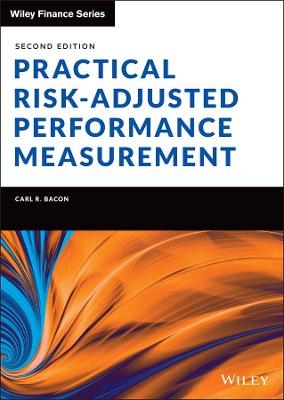
Practical Risk-Adjusted Performance Measurement
John Wiley & Sons Inc (Verlag)
978-1-119-83884-5 (ISBN)
In the newly revised Second Edition of Practical Risk-Adjusted Performance Measurement, accomplished risk and investment expert Carl R. Bacon delivers an insightful, accessible, and real-world guide to ex-post risk measurement. The author bridges the gap between theory and practice, showing you how to apply the former to the latter without introducing unnecessary mathematical complexity.
The book describes the fundamentals of risk in the asset management context and the descriptive statistics used to describe it. It builds on that foundation with detailed examinations of concepts like regression, drawdown, and partial moments, before moving on to topics like fixed income risk and Prospect Theory.
With helpful additions that include recently developed measures of risk, supplementary explanatory sections, and six brand-new chapters, this book also offers:
A practical classification of all ex-post risk measures and how they connect to one another
An explanation of how risk-adjusted performance measures impact performance fees
A discussion of risk measure dashboard designs
Instructions on how appraisal measures should be used for manager selection
Perfect for portfolio managers, asset owners, risk controllers, and investment performance analysts, Practical Risk-Adjusted Performance Measurement is an indispensable resource for anyone looking for a hands-on exploration of the buy-side, asset management perspective.
CARL R. BACON, CIPM, is Chief Advisor to Confluence. He is a member of the Advisory Board of the Journal of Performance Measurement and Founder of The Freedom Index Company. He was formerly Chairman of StatPro Plc from 2000 to 2017.
Chapter 1 Introduction 15
Definition of risk 15
Risk types 15
Risk management v Risk control 18
Risk aversion 19
Ex-post and ex-ante 19
Dispersion 20
Chapter 2 Descriptive statistics 21
Mean (or arithmetic mean) 21
Annualised return 22
Continuously compounded returns (or log returns) 22
Winsorised mean 23
Mean absolute deviation (or mean deviation) 24
Variance 25
Mean difference (absolute mean difference or Gini mean difference) 30
Relative mean difference 31
Bessel’s correction (population or sample, n or n-1) 31
Sample variance 35
Standard deviation (variability or volatility) 36
Annualised risk (or time aggregation) 37
The Central Limit Theorem 38
Frequency and number of data points 38
Alternative risk annualisation methods 39
Normal (or Gaussian) distribution 40
Histograms 42
Skewness (Fisher’s or moment skewness) 43
Sample skewness 44
Kurtosis (Pearson’s kurtosis) 45
Excess kurtosis (or Fisher’s kurtosis) 47
Sample kurtosis 47
Bera-Jarque statistic (or Jarque-Bera) 48
Covariance 53
Sample covariance 54
Correlation (𝜌) 54
Sample correlation 55
Autocovariance 55
Autocorrelation (or serial correlation) 57
Annualised variability if returns are autocorrelated 60
Chapter 3 APPRAISAL MEASURES 62
Performance appraisal 62
Sharpe ratio (reward to variability, Sharpe index) 63
Roy ratio 65
Risk-free rate 66
Alternative Sharpe ratio 66
Revised Sharpe ratio 67
Adjusted Sharpe Ratio 68
Skew-adjusted Sharpe Ratio 69
Skewness-Kurtosis ratio 74
Alternative adjusted Sharpe Ratios 74
Smoothing-adjusted Sharpe Ratio 75
MAD ratio 76
Gini ratio 76
Relative risk 77
Tracking error (or tracking risk, relative risk, active risk) 77
Relative skewness 78
Relative kurtosis 79
Information ratio 79
Geometric information ratio 80
Modified information ratio 87
Adjusted information ratio 88
Skew-adjusted information ratio 88
Chapter 4: Regression Analysis 94
Regression analysis 94
Regression equation 95
Regression alpha 95
Regression beta 95
Regression epsilon 95
Capital Asset Pricing Model (CAPM) 96
Beta (𝛽) (systematic risk or volatility) 97
Jensen’s alpha (Jensen’s measure or Jensen’s differential return or ex-post alpha) 97
Annualised alpha 98
Bull beta (𝛽+) 106
Bear beta (𝛽-) 106
Beta timing ratio 106
Market timing 107
Systematic risk 115
Correlation 115
R2(or coefficient of determination) 116
Specific (or residual) risk 117
The Geometry of Risk 120
Treynor ratio (Reward to volatility) 124
Modified Treynor ratio 124
Appraisal ratio (or Treynor-Black ratio) 125
Modified Jensen 126
Fama decomposition 126
Selectivity 127
Diversification 127
Net selectivity 127
Fama-French three factor model 128
Three factor alpha (or Fama-French alpha) 129
Carhart four factor model 129
Four factor alpha (or Carhart’s alpha) 130
Types of Alpha 130
Multi-factor Models 131
Chapter 5 Drawdown 132
Drawdown 132
Average drawdown 132
Maximum drawdown 133
Largest individual drawdown 133
Recovery time (or drawdown duration) 133
Drawdown deviation 134
Ulcer index 134
Pain index 135
Calmar ratio (or Drawdown ratio) 136
MAR ratio 136
Sterling ratio 136
Sterling-Calmar ratio 137
Burke ratio 138
Modified Burke ratio 138
Martin ratio (or Ulcer performance index) 138
Pain ratio 138
Active (or relative) Drawdown 143
Chapter 6 Partial Moments 148
Downside risk (or semi-standard deviation) 148
Downside potential 149
Pure downside risk 149
Half variance (or semi-variance) 149
Upside risk (or upside uncertainty) 150
Mean absolute moment 150
Omega ratio (Ω) 151
Bernardo & Ledoit (or gain–loss) ratio 151
d ratio 151
Omega-Sharpe ratio 152
Sortino ratio 153
Reward to half-variance 153
Downside risk Sharpe ratio 154
Downside information ratio 154
Sortino-Satchell ratio 155
Kappa ratio 155
Upside potential ratio 156
Volatility skewness 156
Variability skewness 157
Farinelli- Tibiletti Ratio 160
Gain-loss skewness 160
Downside Skewness & Kurtosis 161
Sortino Ratio with higher order moments 161
Chapter 7 Prospect Theory 165
Prospect ratio 165
New Prospect ratio 166
Omega-Prospect ratio 166
Chapter 8 Extreme Risk 170
Extreme events 170
Extreme value theory 170
Value at Risk (VaR) 170
Relative VaR 171
Ex-post VaR 171
Potential upside (gain at risk) 172
Percentile rank 172
VaR calculation methodology 175
Parametric VaR 175
Modified VaR 176
Historical simulation (or non-parametric) 177
Monte Carlo simulation 177
Which methodology for calculating VaR should be used? 178
VaR Interpretation 178
Frequency and time aggregation 180
Time horizon 180
Window length 181
Reward to VaR 181
Reward to relative VaR 182
Double VaR ratio 183
Conditional VaR (expected shortfall, tail loss, tail VaR or average VaR) 183
Upper CVaR or CVaR+ 184
Lower CVaR or CVaR- 184
Tail gain (expected gain or expected upside) 186
Conditional Sharpe ratio (STARR ratio or reward to conditional VaR) 191
Modified Sharpe ratio (reward to modified VaR) 191
Tail risk 191
Tail ratio 192
Rachev ratio (or R ratio) 192
Generalised Rachev ratio 194
Drawdown at risk 194
Conditional drawdown at risk 194
Reward to conditional drawdown 195
Generalised Z ratio 195
Chapter 9 Fixed Income Risk 197
Pricing fixed income instruments 197
Redemption yield (yield to maturity) 197
Weighted average cash flow 197
Duration (effective mean term, discounted mean term or volatility) 198
Macaulay duration 198
Macaulay-Weil duration 199
Modified duration 199
Portfolio duration 200
Effective duration (or option-adjusted duration) 202
Duration to worst 204
Convexity 204
Modified convexity 205
Effective convexity 205
Portfolio convexity 207
Bond returns 207
Duration beta 209
Reward to duration 209
Chapter 10 miscellaneous Risk Measures 210
Upside Capture Ratio (or up capture indicator) 210
Downside capture ratio (or down capture indicator) 210
Up/down capture (or Capture ratio) 211
Up number ratio 216
Down number ratio 216
Up percentage ratio 217
Down percentage ratio 217
Percentage gain ratio 217
Batting Average (or Relative Batting Average) 217
Hurst index (or Hurst exponent) 218
Relative Hurst Index (or Active Hurst) 225
Bias ratio 231
Active Share 237
K ratio 239
Chapter 11 Risk-adjusted Return 248
Risk-adjusted return 248
M2 248
M2 excess return 250
Differential return 250
GH1 (Graham & Harvey 1) 252
GH2 (Graham & Harvey 2) 252
Correlation and risk-adjusted return M3 253
Return adjusted for downside risk 253
Adjusted M2 257
Skew-adjusted M2 257
Omega excess return 258
Chapter 12: A Periodic Table of Risk Measures 259
A Periodic Table of Risk Measures 259
Periodic Table Design 260
Filling the Periodic Table 261
Notation 264
Chapter 13: Risk-adjusted Performance Fees 269
Performance Fees 269
Asymmetric or Symmetric 269
Performance Fees in Practice 273
Chapter 14: Performance Dashboards 276
Effective dashboards 276
Data visualisation tools 277
Chapter 15: Manager Selection 279
Asset Manager Selection 279
Manager Evaluation 280
Portfolio Evaluation 281
Monitoring and Control 282
Chapter 16: The Four Dimensions of Performance 284
Ex-post Return (The traditional dimension) 285
Ex-post Risk (The neglected dimension) 285
Ex-ante Return (The unknown dimension) 285
Ex-ante Risk (The “sexy” dimension) 286
Risk efficiency ratio 286
Performance efficiency 287
Ex-ante Risk Standards 287
Consistency in calculations and comparison 288
Disclosure 288
Recognition of adherence to best practice 288
More robust internal process and control 288
Chapter 17: Which Risk Measure to Use? 291
Why measure ex-post risk? 291
Which risk measures to use? 291
Hedge funds 295
Smoothing 296
Outliers 299
Data mining 300
Risk measures and the Global Investment Performance Standards (GIPS®) 300
Fund rating systems 303
Which measures are actually used? 304
Which risk measures should really be used? 309
Common Errors to avoid 310
Chapter 18: Risk Control 311
Regulations in the investment risk area 311
Risk control structure 312
Risk management 313
Glossary of Key Terms 318
Appendix A – Composite Internal Risk Measures 321
Bibliography 323
| Erscheinungsdatum | 22.10.2021 |
|---|---|
| Reihe/Serie | The Wiley Finance Series |
| Verlagsort | New York |
| Sprache | englisch |
| Maße | 178 x 249 mm |
| Gewicht | 794 g |
| Themenwelt | Wirtschaft ► Allgemeines / Lexika |
| Wirtschaft ► Betriebswirtschaft / Management ► Finanzierung | |
| Betriebswirtschaft / Management ► Spezielle Betriebswirtschaftslehre ► Bankbetriebslehre | |
| ISBN-10 | 1-119-83884-3 / 1119838843 |
| ISBN-13 | 978-1-119-83884-5 / 9781119838845 |
| Zustand | Neuware |
| Informationen gemäß Produktsicherheitsverordnung (GPSR) | |
| Haben Sie eine Frage zum Produkt? |
aus dem Bereich


